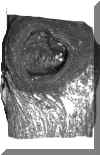|
In
the advanced stages of decay, wood is consumed by
fungi and insects resulting
in rot and/or cavities. Rot might develop from bark
wounds, breakage (Figure 1), and prunning wounds.
Cavities often form after flush
cuts or stub cuts. Older trees occasionally have large
cavities or rot in their trunks and main branches
(Harris, 1992). Either way, rot and/or cavities indicate
serious decay and structural
problems (Figure 2).
The rotten wood may be
soft enough that it can be crumbled between your fingers.
It may be wet and spongy or dry and powdery. Trees
may have a scar, but the wood is still gray and hard
without any sign of decay.
 |
| Figure
2 |
|
 |
| Figure
1 |
|